Major exercises scheduled on November 9 – The day of close approach of asteroid 2005 YU55
Two major hazard excercise are scheduled for November 9 2011 and also close approach of asterois 2005 YU55. Testing of Emergency Alert System (EAS) and PACWAVE11, a multi-scenario exercise that will allow PTWS countries to exercise using a destructive local or regional tsunami scenario are to be held on the date.
Nationwide Emergency Alert System (EAS) Test
FEMA, in coordination with the Federal Communications Commission (FCC) and the National Oceanic and Atmospheric Administration (NOAA), will conduct the first nationwide Emergency Alert System (EAS) Test on November 9, at 2:00 p.m. Eastern.
The nationwide EAS Test will be conducted jointly by the Department of Homeland Security (DHS) Federal Emergency Management Agency (FEMA), the Federal Communications Commission (FCC), and the National Oceanic and Atmospheric Administration’s (NOAA) National Weather Service (NWS).
FEMA will test the readiness and effectiveness of the EAS. EAS Participants provide a critical public service to the nation as the resilient backbone of alert and warning when all other means of communication are unavailable. That includes all broadcasters, satellite and digital radio and television, cable television and wireline video providers who ensure the system is at a constant state of readiness.
The alert and warning landscape is in an important state of transition; from the current system of radio, television, cable, satellite, and wireline broadcast media-based alerting to a future system that integrates new technologies for a more universal access to alert and warning messages. Future testing of the EAS will assess the effectiveness and reliability of other technologies to achieve the ultimate goal of timely alert and warning to American public in the preservation of life and property.
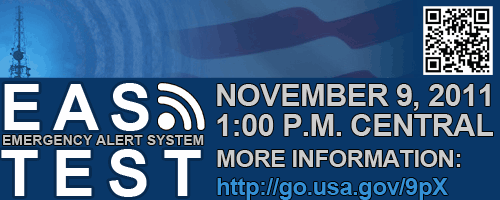
The national-level EAS leverages the communications support of all participating analog and digital radio, television, cable, satellite, and wireline providers (also known as EAS Participants) through specialized EAS equipment. A single, live-code alert, called the Emergency Action Notification, (EAN) is sent simultaneously to Primary Entry Point (PEP) stations across the country. PEP stations are designated to relay national alerts to the public and other stations in their coverage area. Local Primary (LP-1) EAS Participants monitor the PEP stations and other sources for an EAS message. Other EAS Participating stations also monitor at least two sources (in most cases the PEP and LP-1 stations) to receive the EAS message, and broadcast the message to the public in their area.
During the test, listeners will hear a message indicating that “This is a test.” The text at the top of the television screen may indicate that an “Emergency Action Notification has been issued.” This notification is used to disseminate a national alert and in this case, the test. In addition, the background image that appears on video screens during an alert may indicate that “This is a test,” but in some instances there might not be an image at all.
FEMA stated that they choose this particular date because it is near the end of hurricane season and before the severe winter weather season. The 2 p.m. Eastern broadcast time will minimize disruption during rush hours, while ensuring that the test can occur during normal business hours across several time zones. (FEMA)
Community Medical Excercise
Medical Reserve Corps issued a call for volunteers needed for community medical excercise which is to be held on November 9. Hospital personnel and various first responder agencies from the MidSouth region will participate in a community medical exercise. This exercise will provide practical training experience to prepare for medical response during a large scale event. On Wednesday November 9th, hospital personnel will work with volunteer patients playing the role of injured victims to provide a realistic and practical experience in treatment and response. Volunteers must be at least 18 years of age and preregistration is required. In order to participate in this drill you must be a member of the Medical Reserve Corps.
MILCOM 2011
November 7 -10 is scheduled for MILCOM 2011 / IEEE Military Communications Conference. The unclassified technical program provides a venue for technical papers that do not contain ITAR-sensitive, classified or proprietary information.
 Unclassified technical program includes Waveforms and Signal Processing, Network Protocols and Performance, Cyber Security and Network Operations, Middleware Services and Applications, Communications and Network Systems and Department of Defense Programs.
Unclassified technical program includes Waveforms and Signal Processing, Network Protocols and Performance, Cyber Security and Network Operations, Middleware Services and Applications, Communications and Network Systems and Department of Defense Programs.
Classified technical program includes Track: Satellite Communications, Tactical Applications and Framework, Tutorial: Enhanced Polar System Overview, Radio Technology, Analysis and Capabilities, Security Challenges and Solutions, Command and Control for Cyberspace, Electronic Warfare/ Communication System Compatibilities, Communication System Susceptibilities and Jamming, Network Security and IA Testing and RF.
Excercise Pacific Wave 11
PacWave11 will be held on 9-10 November 2011 as a multi-scenario exercise that will allow PTWS countries to exercise using a destructive local or regional tsunami scenario. PacWave 11 will also be used to introduce new tsunami advisory products of the PTWC. IOC Circular Letter 2390 was issued on 13 May 2011 announcing the exercise and requesting PTWS Countries to nominate a PacWave11 focal point. IOC Manual and Guides 58 on How to Plan, Conduct, and Evaluate Tsunami Exercises was issued in July 2011. The PacWave11 Exercise Manual (IOC TS 97) was published in August 2011.
In August 2010, the PTWS Steering Committee (SC) met to discuss the progress of the PTWS during the intersessional period, including the next PTWS exercise. Considering the general objectives of PACWAVE08, the SC approved the PACWAVE Summary Report and requested Working Groups 2 and 3 (Tsunami Detection, Warning and Dissemination; Tsunami Awareness and Response) to cooperate in the preparation of an end-to-end communication exercise PACWAVE11 in November 2011. The actual evacuation of local communities (or parts of it) will be left to the decision of local or national authorities. A Task Team is to be formed and elaborate on detailed scenarios. PACWAVE11 will be conducted as a multi-scenario exercise to permit all countries to better participate. (ITIC/IOC)
The 10 scenarios available will be:
- Kamchatka (Kuril-Kamchatka Trench)
- Ryukyu Islands (Nansei-Shoto Trench)
- Philippines – South China Sea (Manila Trench)
- Philippines – Pacific Ocean (Philippines Trench)
- Vanuatu (New Hebrides Trench)
- Tonga (Tonga Trench)
- Northern Chile (Peru-Chile Trench)
- Ecuador (Colombia – Ecuador Trench)
- Central America (Middle America Trench)
- Aleutian Islands (Aleutian Trench)
Travel times are calculated using a point source corresponding to the earthquake epicenter. The software (TTT SDK, Geoware) is used by the NOAA Pacific Tsunami Warning Center, and is available to tsunami warning centers and responsible national tsunami agencies from ITIC/NGDC.
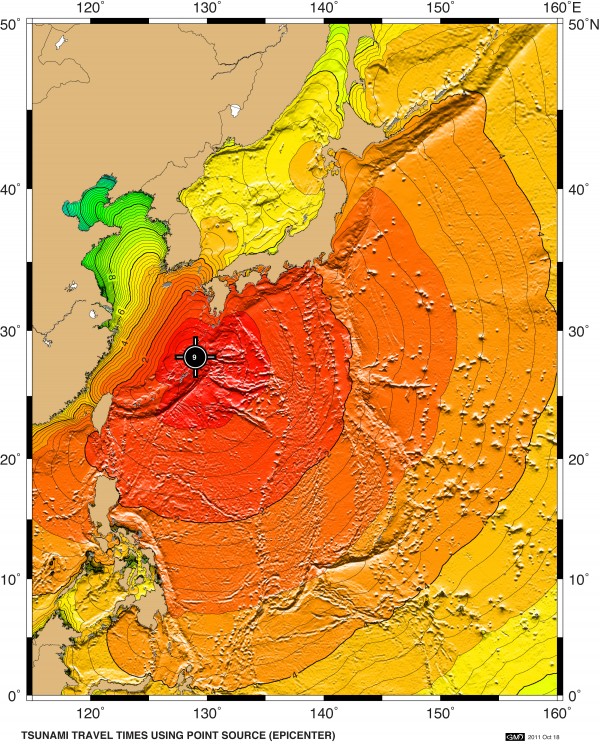
Documents |
2005 YU55 close approach
On 29 April, NASA announced on their website that a massive asteroid will moving very close to earth. It will closer than the moon which orbits 238,857 miles away on average.
This giant asteroid called YU55 founded by Robert McMillan, head of the Nasa-funded Spacewatch Program at the University of Arizona, Tucson since December 2005. It orbits the sun once every 14 year but it is not close to the earth for at least a decade.
Asteroids come within the moon’s distance every so often, but 2005 YU55 is the biggest known asteroid to do so for about the next 17 years. Officially, the asteroid poses no immediate threat to Earth. Its orbit is well known to astronomers – so well known that we can rule out an impact for at least the next century.
According to NASA’s Near Earth Object Program:
Although classified as a potentially hazardous object, 2005 YU55 poses no threat of an Earth collision over at least the next 100 years. However, this will be the closest approach to date by an object this large that we know about in advance and an event of this type will not happen again until 2028 when asteroid (153814) 2001 WN5 will pass to within 0.6 lunar distances.
The animation below, from NASA’s Jet Propulsion Laboratory, shows this asteroid’s sweep past Earth on November 8 and 9.
While this is the largest asteroid (that we know of) to swing past us for the next 17 years or so, YU55 is not an immediate threat to Earth. Its orbit does bring it close enough to our planet that it’s been deemed a potentially hazardous asteroid, but the orbit is well-enough known that we can rule out an impact for at least the next century.
You can see the Earth at the center (the diagonal line if the Earth’s orbit around the Sun), the Moon orbiting the Earth, and the path of YU55. The scale on the bottom is a million kilometers, about 620,000 miles. The Moon’s orbit is roughly 770,000 km (475,000 miles) wide. The path of YU55 cuts a shallow chord across the Moon’s orbit, well away from our planet.
Still, there’s a chance for some real science on this rock. At that distance, it’ll appear so small (1/4 arcseconds across, where the Moon is 1800 arcsec across for comparison) that it’ll be too small even for Hubble to make much of it — at best, in Hubble’s cameras it will appear to be just two pixels across. And that’s even if Hubble could track it, which it can’t.
But the Deep Space Network of radio telescopes can actually get very high resolution imagery using sophisticated techniques, possibly getting images with a resolution of just 4 meters — the size of an SUV — on the asteroid. That means YU55 will be 100 pixels across, enough to see some details on the surface, including craters, boulders, and even possibly a moon if it has one. (BadAstronomy)
The risk of asteroid impact causing tsunami
If an asteroid of size 200 meters hit the ocean (which covers 70% of the Earth), the tsunami would create inflict of catastrophic destruction of coastal cities and substantial worldwide human casualties along coastlines. If an asteroid of size 1 kilometer hit Earth, it would cause a dust cloud which would block out sunlight for at least a year and lead to a deep worldwide winter, exhausting food supplies. The latter is what caused the dinosaur extinction, as well as other major extinctions of smaller creatures in geologic time scales. The 200 meter asteroid hits, which are far more common than the 1 km+ hits, wouldn’t show up much in geologic histories on a global scale.
The statistics on the chances of a near Earth object hitting Earth are vague and subject to change, particularly as regards smaller, Tsunami-sized hits. In the general press, too much emphasis is put on the big, 1 km size asteroids like the one that killed off the dinosaurs, which are unlikely to hit Earth for hundreds of thousands of years. Too little coverage is given on the small asteroids which could cause terrible local destruction but little worldwide impact, and which probably hit once per hundred years. We have good statistical numbers on the big asteroids of 1 km and up, but very little information on the smaller 100 meter asteroids which we still would be lucky to see, and we can’t really say how prevalent such small fragments are relative to the big asteroid chunks. Our best telescopes can hardly see the 100 meter asteroids because they’re so small, hence the vague statistics. (Pernament)
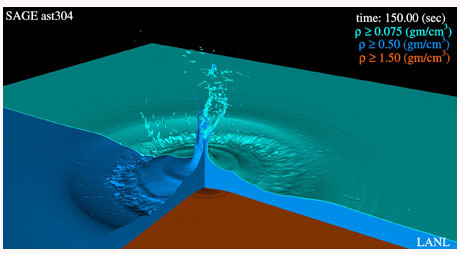
Image from a 3-D calculation of an asteroid impact model in 2002, in which the jet from the transient crater is collapsing and producing a wave of a couple kilometers initial amplitude.
There is uncertainty about the diameter of many asteroids when they are initially discovered. These objects are generally so small and so far away that their diameter has to be inferred from their absolute magnitude. Brightness, in turn, depends on the object’s albedo (amount of light reflected from the surface). An object of magnitude 23 might have a diameter between 65m and 108m. Furthermore, with limited observations, the absolute magnitude may vary by +/-0.5 therefore the estimated diameter can range from 50m to 190m.
Iron asteroids are more likely to reach the ground intact. They comprise perhaps 5% of the smaller asteroids and are disregarded in this analysis.
Although, for a given location on the Earth’s surface, the risk of a “direct” hit from an asteroid is slight, researchers realized that an ocean impact had the potential to be much more destructive due to the effects of tsunami. An airburst explosion is a three dimensional event and energy decreases according to the square of the distance but a radiating ocean wave is a two-dimensional phenomenon and, in theory, energy decreases in proportion to distance. Since the early 1990s some advanced computer simulations have been conducted to estimate the effects of asteroid impacts above deep oceans.
- For an impact to produce a coherently propagating wave, the “cavity” must be 3 to 5 times broader than the depth of the ocean. Using a rule-of-thumb (derived from simulations) that the cavity diameter is 20 times the asteroid diameter then, for a typical ocean depth of 4km, the impactor must be at least 1 km in diameter to produce a coherent wave. On this basis, for asteroids smaller than about 1km, the wave will dissipate considerably as it travels over thousands of kilometres of ocean.
In the case of asteroids 200m and larger there is likely to be an impact into the ocean. For objects under this diameter there is a reduction in the size of the deepwater wave due to energy dissipation in the atmosphere. Speed, trajectory, density and strength of the object can affect the nature of the explosion. There does not appear to be an empirical formula available to deal with these smaller objects and it is possible that the smaller asteroids produce no appreciable waves. On the other hand, in the case of serious tsunami generated by earthquakes the energy involved is estimated to be equivalent to about 2 Megatons of TNT (Yabushita 1998). The impact by a 100m asteroid typically involves kinetic energy of about 75Mt so it would only involve the conversion of about 3% of this energy to wave energy in order to produce a serious tsunami – albeit, the tsunami could quickly dissipate, compared with an earthquake generated tsunami.
The radius derived for a 50m asteroid is about the same as the radius of direct devastation for the Tunguska event. Impacts by asteroids 2km and larger exceed the global catastrophe threshold and are disregarded for the purpose of analysing tsunami effects.
Estimated deepwater wave height (above sea level) at a point 100km from asteroid impact (based on extrapolation of Crawford & Mader):
| Asteroid Diameter (m) | |
50 | 0.12 |
100 | 0.7 |
200 | 3 |
500 | 22 |
1 km | 70 |
2 km | 230 |
This tentative analysis suggests that the risk to a low-lying coastal area from tsunami generated by asteroids is significantly greater than the risk from a “direct” impact by such objects. The average interval between such tsunami events is estimated to range from about 190,000 years for a location with a run-up factor of 40 to about 3 million years for a location with a run-up factor of 5. These compare with an average interval of 14 million years for a “direct hit”.
In some circumstances an ocean impact might even be less hazardous to mankind than a land impact because less debris will be thrown into the atmosphere and indirect effects might be reduced.
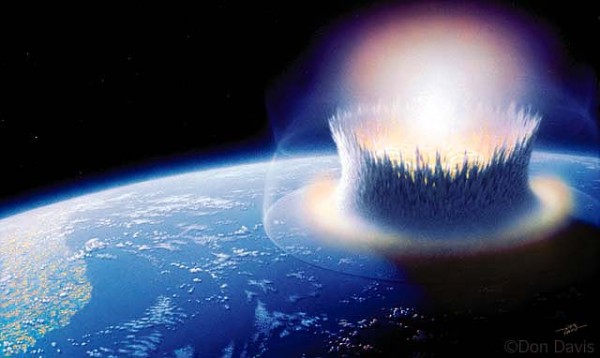
The dramatic picture by Don Davis is a little misleading. When an asteroid hits the ocean at 70 000km/h there is a gigantic explosion. The asteroid and water vaporize and leave a huge crater - typically 20 times the diameter of the asteroid (that is, a 100m asteroid will create a 2 kilometre diameter crater). The water rushes back in, overshoots to create a mountain of water at the middle and this spreads out as a massive wave - a tsunami. The centre of the "crater" oscillates up and down several times and a series of waves radiate out.
The risk from asteroid tsunami has been substantially overstated – particularly in popular books about asteroid impacts with Earth. For typical coastal regions the risk of dying from an asteroid-generated tsunami is probably no greater than that of dying from the indirect effects of a large asteroid striking the Earth.
For some coastal regions with unusual vulnerability to tsunami the risk of dying from asteroid-generated tsunami may be several times greater than that of dying from other asteroid-related causes. For these highly vulnerable areas the typical interval between asteroid tsunami events is likely to be about 200,000 years – assuming that impacts are randomly distributed in time. (AustralianSpaceGuardSurvey)




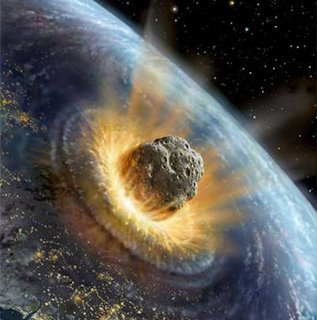

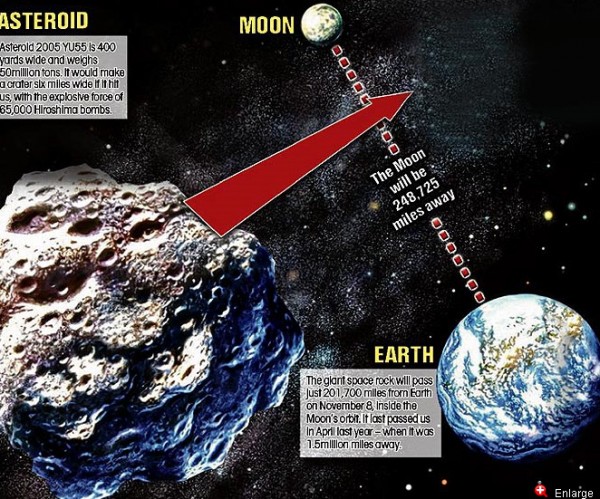
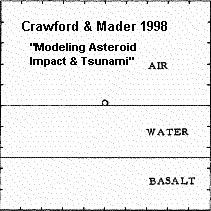
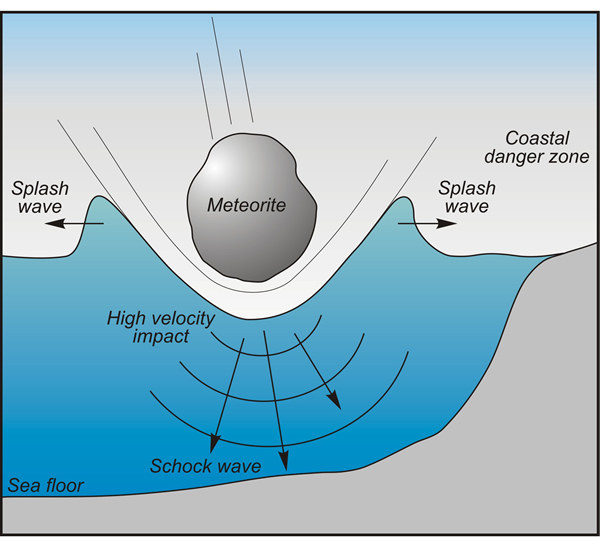








No comments